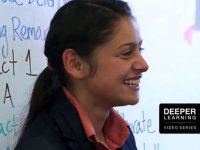A Defense of Deeper Learning: Watch What’s Working, Part 3
"Everything I worked so hard for, it really all paid off in that moment when they told me I passed."
What is the structure of a College Success Portfolio (CSP)? What goes into it, and how do the pieces work together?
The CSP is a collection of a student's best work, evidence that she has, over the course of four years of high school, mastered the academic content and developed the right skills to succeed in college and beyond.
At Envision Schools, our seniors put together a complete portfolio that includes three main elements:
Their thesis: This is their main argument for why they are ready for college. Sometimes, students frame this as their personal Philosophy of Education, their own expression of what education means to them and how it will carry them into the future. At a recent defense at Envision Academy, one senior's Philosophy of Education was this: Education is about "falling until one learns how and where to stand."
Their metaphor: Students choose a metaphor that represents their own journey toward high school graduation. This provides a through-line for all the student's artifacts and makes the defense even more personalized and engaging for the panel and audience.
Their artifacts: Students must include five certified artifacts in their portfolio, covering all of the academic disciplines as well as demonstrating the leadership skills Envision prioritizes: collaboration, critical thinking, communication, and project completion. The certification process means that each piece of work meets the standards for being proficient or above. From the five artifacts, students choose three to present at their defense.
Bringing these three elements together, they must talk about how the work they have done relates to their main argument and their metaphor. They must be ready to describe the leadership skills and the content knowledge they gained in the process. They will be asked to reflect on their growth and on the areas they still have to improve. Taken together, all of these parts help a student prove that she is ready to graduate and take on the next challenge in her life.
You can see how one Envision student, Yvonne, brings all of this together in Student Profile-Portfolio Defense, the second of the Envision Education videos that are part of The Teaching Channel's new Deeper Learning series. (As a reminder, this series contains 50+ videos showcasing 10 Deeper Learning networks from all over that country that are preparing students for success; collectively, they serve more than 500 schools and 227,000 students.)
One of the most useful aspects of this video is watching how the members of Yvonne's defense panel push her to go deeper, asking challenging questions about her artifacts and her learning. They asked her:
- How does each of your artifacts show your growth and progress as a learner?
- Where were you asked to think critically about the novel The Stranger?
- Tell us more about what you see as the connection between knowing and doing
These questions show how Envision teachers push students to demonstrate the full range of what their education has prepared them for. Join the conversation in the comments by responding to the questions that follow. Share your own ideas and questions with the Edutopia community. Watch Yvonne's defense.
Questions to Move Us Forward
- What is your favorite question to ask your students to make them "go deeper?"
- Although you only viewed a few minutes of Yvonne's defense, what are the wows (positive feedback) and wonders (probing or pushing questions) you would give Yvonne?
